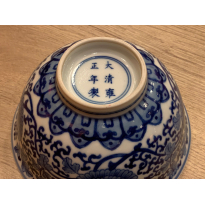Years pass by, a dream of a millennium. The history and characteristics of Chinese blue and white porcelain.
Why has blue and white porcelain dominated the mainstream in China for hundreds of years? What is blue and white porcelain, something many people may not fully understand? Taiwanese musician Jay Chou named a popular song "Blue and White Porcelain," sculpting the Chinese style. So, what are the characteristics of blue and white porcelain? Why can it represent Chinese culture? Why is it so beloved? I believe there are reasons behind it all! Blue and white porcelain has flourished for thousands of years, and today, the author will try to answer this mystery for everyone, hoping to help readers gain a deeper understanding of traditional Chinese culture.
Friends often have a question: What is blue and white porcelain? What is blue and what is white? What about blue porcelain? In fact, blue and white porcelain and blue porcelain are two different concepts, with significant differences in substance! Blue is a color, somewhere between green and blue, poetic like "the river appears blue and green in spring." The craftsmanship of blue and white porcelain is very complex. It is made using cobalt as a coloring agent, along with transparent glaze, fired at a high temperature (around 1280 degrees) in one firing! Due to the stable coloration of cobalt, the finished product rate is very high, cost-effective, and gradually became the mainstream of porcelain development!
Chinese porcelain is refined, with a smooth body, and painting different blue patterns on a clean white body is very beautiful, like painting on Xuan paper. The ink is divided into five colors, with different shades, transitioning between colors, like a ink painting, making it particularly popular!
In Chinese culture, blue represents auspicious meanings, such as "blue is better than indigo," "achieving great things and making a mark in history," and so on. Therefore, the Chinese have a special affection for the color blue, which cannot be easily diluted!
The origin and related culture of blue have been explained. So what about "flowers"? It's actually quite simple. "Flowers" represent the floral patterns, artistic designs are considered as flowers. Chinese porcelain patterns include dragon and phoenix patterns, floral patterns, figures, and stories, all of which are important components of Chinese culture and are warmly welcomed by us!
Blue and white porcelain has a history of over 1000 years in China. The earliest was Tang blue and white. In 1998, seven complete blue and white porcelain items were discovered in an Arab sunken ship found in Indonesia. Although the patterns were relatively simple and the volume was not large, it was a big news at the time due to its long history, arousing global attention! Traditionally, we believe that blue and white porcelain did not exist in the Song Dynasty, but matured in the Yuan Dynasty and became popular in the Ming and Qing Dynasties, especially during the Yongle, Xuande, and Kangxi periods. Kangxi blue and white porcelain during the Qing Dynasty was particularly loved by collectors. The body of Kangxi blue and white porcelain is smooth, the decoration is elegant, and the shape is simple yet dignified, cherished by the world.
So, what is "qingci"? Many antique porcelain in China can be called "qingci". As long as porcelain made with iron oxide under reducing atmosphere firing, it can be called "qingci," mainly in blue, occasionally with yellow, which are the Five Famous Kilns in China! Among them, Ru kiln's sky-blue color is especially beloved. The color of "sky-blue" appears after a rain when the sky is clear, faintly blue, very beautiful and natural. This color was favored by Emperor Taizong of Later Zhou and Emperor Huizong of Song Dynasty. Ru kiln has agate glaze, under different lighting conditions, the color changes unpredictably, so it is particularly popular!
More than ten years ago, the song "Blue and White Porcelain" composed by Jay Chou, with lyrics by Vincent Fang, has a line: "Under the clear sky, waiting for the misty rain, while I'm waiting for you." After its release, it became very popular, a rare masterpiece! The story describes the protagonist encountering a naturally beautiful woman in the misty rain of the Jiangnan water town, yearning for her eagerly. The melody of the song is light and beautiful, the chorus is catchy, and everyone loves it. But "sky-blue" is not the characteristic of blue and white porcelain. The creator's choice of "Blue and White Porcelain" as the song title is mainly because "blue and white" has an elegant and Chinese style, poetic, and easy for listeners to accept. I think artistic creation does not necessarily need to be consistent with reality. In addition, Han Dynasty's calligraphic style is not commonly used on blue and white porcelain, because blue and white porcelain mainly uses seal script or regular script!
Chinese porcelain has beautiful shapes. I think using a Guanyin vase to represent the naturally beautiful woman is the best choice, because the Guanyin vase has a graceful and slender figure, much like a young and beautiful girl, which makes people love it, right?
Blue and white porcelain has a history of thousands of years in China, and after the Yuan and Ming Dynasties, it became the mainstream product of Jingdezhen. The blue and white porcelain of the Yongle and Xuande periods is especially cherished! The most famous feature of blue and white porcelain is the sapphire blue, which looks especially elegant against the white glaze. Of course, blue and white porcelain and "sky-blue" are unrelated. Basically, there is no connection. It's just the personal choice of the song's creator, so there's no need to be overly concerned about this inconsistency!
Author
Mr. Robert T Li graduated from the Economics Department of the University of Hong Kong and has served as the Head of Liability Insurance in the Greater China region for an international insurance company. He has a passion for traditional Chinese culture and enjoys collecting art. He is actively involved in promoting awareness of traditional Chinese culture, music, and art among young people. He can be contacted at litaichai@gmail.com.
Uploaded on 2024.4.2




